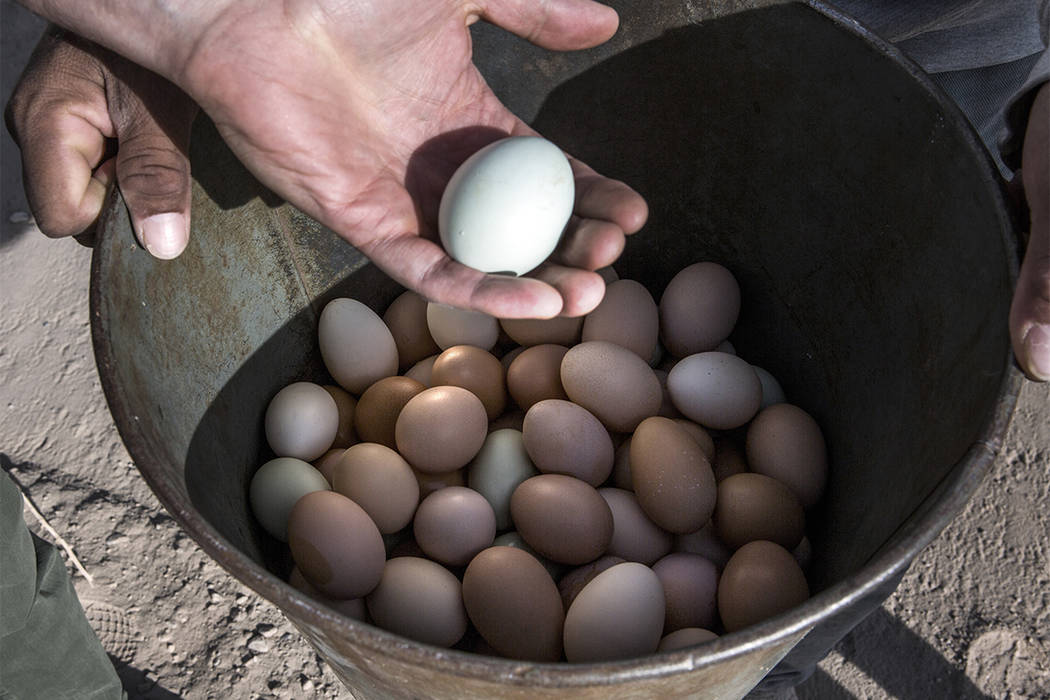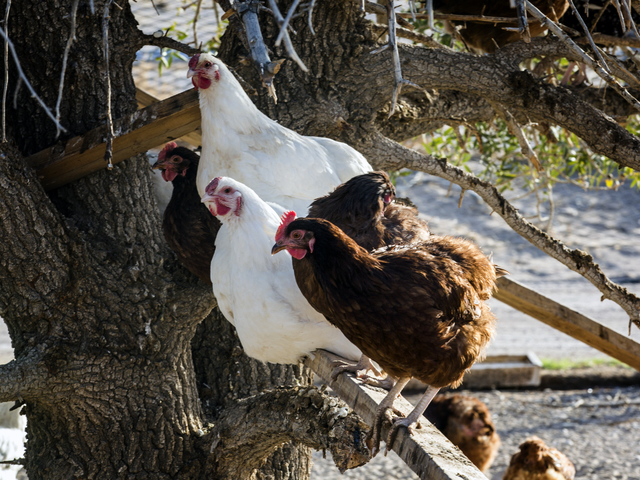The perfect egg a worthy pursuit at Nevada ranch
For Brett Ottolenghi, the target is clearly in sight.
“We’re pursuing the perfect egg,” said Ottolenghi, owner of Artisanal Foods, which has a local retail store and whose products are in the kitchens of numerous Strip restaurants. “We want to prove you can do things on a large scale and still do it properly.”
It’s not his first food crusade. The “we” in Ottolenghi’s declaration is business partner Michael DeLee, a Las Vegas attorney he met while the former was trying to get raw milk legalized in Nevada. (The measure passed the Legislature in 2013, but was vetoed by Gov. Brian Sandoval.)
“He taught me how to lobby and do a whole lot,” Ottolenghi said. “After the raw milk veto, I was thinking what’s the next best product we can provide?”
That would be eggs, which the partners and DeLee’s brother, Jon, are working to produce on the DeLees’ ranch in Amargosa, an agricultural community about 90 miles northwest of Las Vegas.
The eggs are being produced in the most natural way possible. Twenty acres of the 2,300-acre ranch are pocked with old pistachio trees, which Ottolenghi said are the ideal habitat for chickens. When the operation was launched in 2016, they built a 3-acre pen where 1,100 hens lived and laid eggs.
“Chickens are naturally jungle fowl,” he said. “They would like to live in the lower branches of trees, which protect them from above and below.”
In traditional commercial egg-laying operations, Ottolenghi said chickens are usually crammed into small spaces, away from sunlight and fresh air. Conditions for “free-range” chickens are not much better.
There’s another advantage to raising the hens in the old pistachio grove: The chickens eat pistachios when they drop, along with pomegranates, which also were grown on the ranch. That’s very different from what the majority of American chickens eat. Ottolenghi said in the U.S., chicken feed generally is mostly corn with a little soybean, and since 88 percent of corn and 93 percent of soybeans produced in this country are genetically modified, the vast majority of eggs are from chickens fed GMO feed.
“The most healthy diet is a diverse diet,” he said. “If somebody is growing chickens in their backyard and feeding them table scraps, you’re going to get a really great egg.”
All those Strip restaurants notwithstanding, they don’t have enough table scraps to go around, so they’ve started raising triticale on the ranch. Triticale, which dates to the late 19th century, is a cross between wheat and rye. They mix it with alfalfa or clover to diversify the diet.
“It’s more nutritious than a standard chicken would be getting, but there’s still a lot of room for improvement,” Ottolenghi said. “We’re looking into things like marigolds.”
To produce eggs, they have to produce feed. But they also need to produce hens; in order to be commercially viable, they need 20,000. After experimenting with 10 heritage breeds, they settled on the Whiting True Blue.
“This chicken is key to our production,” Ottolenghi said. The breed has a high yield, he noted, and produces an egg that’s a distinctive blue: “When you open that box, I need a visual difference” to distinguish them in the market. “Nobody will be able to copy us.”
But that raised another issue: obtaining the chickens. The supplier they initially approached for 2,000 Whiting True Blue chicks could provide only 250.
“What it told us is we need to be in the hatchery business,” he said.
They’re trying to obtain 10,000 hens by the end of the year — either purchased or hatched on the ranch — and have decided to at least temporarily use Red Stars, or Rhode Island Reds, as a supplement.
“I would like to work our way to the Whiting True Blues, but we need to get our numbers up as soon as possible,” he said.
They started getting chicks in late February and expect shipments through August. Once the chicks are about 5 months old, they’ll start breeding them. Ottolenghi pointed out they need to breed twice as many as they need, since roughly half will be roosters.
Which brings up the next issue: What to do with the extra roosters — and all those hens, since they lay for only about three years. Ottolenghi is considering branching out even further and establishing a portable slaughterhouse. There are none in the state, he said, and it could be used by numerous small producers.
They also need to establish a market for the eggs. They’re currently producing 300 dozen a week; ramping up production will provide benefits through economy of scale. But they’ll retail for $6 to $8 a dozen, and it is unclear if consumers will pay that. Ottolenghi said there’s a Northern California operation that produces 1,400 dozen eggs a day, with retail prices of $8.50 to $11 a dozen.
There’s more to be done, much of it because of the pastoral nature of the operation. They’re constructing more 3-acre pens, need to refine water supply and drainage, and add lighting so production doesn’t slow in the winter, as it did this year.
And they’ve had a few hawk attacks. For that reason, Ottolenghi is looking for a rescue dog that was raised on a farm.
“We would love to find a dog that has experience around chickens,” he said. “We could even give it an air-conditioned doghouse, but we need a dog to live with the chickens.”
Contact Heidi Knapp Rinella at Hrinella@reviewjournal.com or 702-383-0474. Follow @HKRinella on Twitter.




































